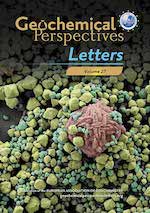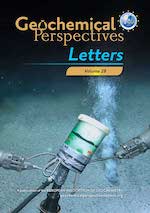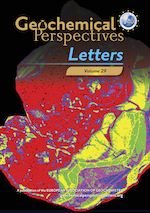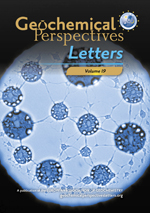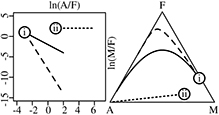 | A genetic classification of the tholeiitic and calc-alkaline magma series Abstract: The concept of the ‘magma series’ and the distinction between alkaline, calc-alkaline and tholeiitic trends has been a cornerstone in igneous petrology since the early 20th century, and encodes fundamental information about the redox state of divergent and convergent plate tectonic settings. We show that the ‘Bowen and Fenner trends’ that characterise the calc-alkaline and tholeiitic types of magmatic environments can be approximated by a simple log ratio model based on three coupled exponential decay functions, for A = Na2O + K2O, F = FeOT and M = MgO, respectively. We use this simple natural law to define a ‘Bowen-Fenner Index’ to quantify the degree to which an igneous rock belongs to either magma series. Applying our model to a data compilation of igneous rocks from Iceland and the Cascade Mountains effectively separates these into tholeiitic and calc-alkaline trends. However the simple model fails to capture the distinct dog-leg that characterises the tholeiitic log ratio evolution, which can be attributed to the switch from ferrous to ferric iron-bearing minerals. Parameterising this switch in a two stage magma evolution model results in a more accurate fit to the Icelandic data. The same two stage model can also be fitted in A–T–M space, where ‘T’ stands for TiO2. This produces a new way to identify calc-alkaline and tholeiitic rocks that does not require the conversion of FeO and Fe2O3 to FeOT. Our results demonstrate that log ratio analysis provides a natural way to parameterise physical processes that give rise to these magma series. |
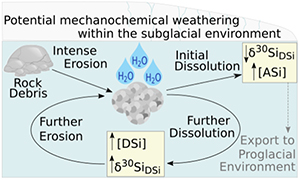 | Physical weathering by glaciers enhances silicon mobilisation and isotopic fractionation Abstract: Glacial meltwaters export substantial quantities of dissolved and dissolvable amorphous silicon (DSi and ASi), providing an essential nutrient for downstream diatoms. Evidence suggests that glacially exported DSi is isotopically light compared to DSi in non-glaciated rivers. However, the isotopic fractionation mechanisms are not well constrained, indicating an important gap in our understanding of processes in the global Si cycle. We use rock crushing experiments to mimic subglacial physical erosion, to provide insight into subglacial isotope fractionation. Isotopically light DSi (δ30SiDSi) released following initial dissolution of freshly ground mineral surfaces (down to −2.12 ± 0.02 ‰) suggests mechanochemical reactions induce isotopic fractionation, explaining the low δ30SiDSi composition of subglacial runoff. ASi with a consistent isotopic composition is present in all mechanically weathered samples, but concentrations are elevated in samples that have undergone more intense physical grinding. These experiments illustrate the critical role of physical processes in driving isotopic fractionation and biogeochemical weathering in subglacial environments. Understanding perturbations in high latitude Si cycling under climatic change will likely depend on the response of mechanochemical weathering to increased glacial melt. |
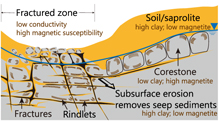 | Subsurface particle transport shapes the deep critical zone in a granitoid watershed Abstract: Understanding the inter-relationships between chemical weathering and physical erosion remains a first order puzzle in Earth surface dynamics. In the Río Icacos watershed in the Luquillo Critical Zone Observatory, Puerto Rico, where some of the world’s fastest weathering of granitoid watersheds has been measured, we show that chemical weathering not only releases dissolved solutes, but also weakens the rock around the fractures until particles detach and are mobilised by subsurface flow through fractures. These sand-sized particles are more weathered than corestones, but much less weathered than soils/saprolites. Subsurface removal of these clay-enriched, magnetite-depleted particles from the fractures could explain zones with enhanced magnetic susceptibility and decreased terrain conductivity that are observed in geophysical surveys. Subsurface particle transport may thus contribute to geophysical signatures and help sustain high weathering fluxes at Río Icacos and other steep and highly fractured landscapes. |
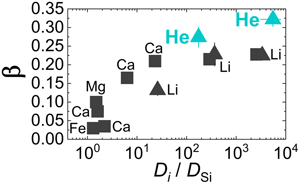 | Diffusional fractionation of helium isotopes in silicate melts Abstract: Estimating Helium (He) concentration and isotope composition of the mantle requires quantifying He loss during magma degassing. The knowledge of diffusional He isotope fractionation in silicate melts may be essential to constrain the He loss. Isotopic mass dependence of He diffusion can be empirically expressed as D3He/D4He = (4/3)β, where D is the diffusivity of a He isotope. However, no studies have reported any β values for He in silicate melts due to technical challenges in both experiments and computations. Here, molecular dynamics simulations based on deep neural network potentials trained by ab initio data show that β for He in albite melt decreases from 0.355 ± 0.012 at 3000 K to 0.322 ± 0.019 at 1700 K. β in model basalt melt takes a smaller value from 0.322 ± 0.025 to 0.274 ± 0.027 over the same temperature range. Based on our results, we suggest using D3He/D4He values of 1.097 ± 0.006 and 1.082 ± 0.008 in natural rhyolite and basalt melt, respectively, to interpret measured He concentration and isotope composition of natural samples. |
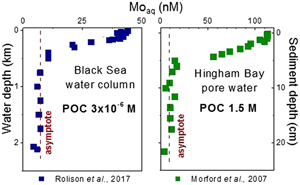 | Dissolved molybdenum asymptotes in sulfidic waters Abstract: Molybdenum enrichment in organic-rich sediments is well known and is an accepted proxy for sulfidic conditions during sedimentation, but debate persists about how Mo enrichment arises. Organic scavenging and sulfide precipitation are the processes most often invoked. When dissolved Mo (Moaq) precipitates solely within sulfidic pore waters of sediments, contiguous particulate organic carbon concentrations (POC) are orders of magnitude higher than when it precipitates in euxinic water columns. Nevertheless, in both cases, Moaq concentrations decline until reaching quite similar asymptotes centred around 7.8 nM. That Moaq asymptotes are independent of organic carbon availability is inconsistent with organic scavenging as the dominant Mo fixing mechanism. In contrast, the FeMoS4 precipitation mechanism predicts both the existence of asymptotes and their POC independence. Because asymptotes block quantitative Moaq precipitation, final δ98Mo values in euxinic marine sediments are apt to be offset from those in seawater, but the difference is small in modern environments because (Moaq)asymptote << (Moaq)seawater. Asymptotes lie above the Moaq concentration believed to limit Mo nitrogenase biosynthesis, suggesting that without substantial acidification, global euxinia cannot deplete Moaq sufficiently to create marine nitrogen crises. |
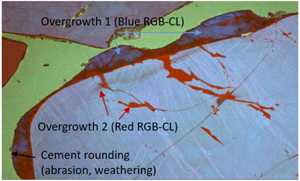 | Insights into past tectonism from authigenic quartz Abstract: Authigenic quartz grains carry information that is diagnostic for the thermal history and thereby the burial depth and uplift of sediments. Recycled quartz grains with embayed or rounded authigenic remnants have been observed globally, but the value of these grains in unravelling past tectonism is presently underexplored. In this study, we launch a new method to demonstrate that cathodoluminescence (CL) in combination with fluid inclusion data and textural characteristics of authigenic quartz can provide important information about past tectonic activity. Vital in the method is the realisation that recycled quartz grains can be distinguished from other quartz grains by their geochemical CL fingerprint, allowing tracking of uplifted source terrains in a direction towards higher fractions of the recycled grains. Furthermore, regional mapping can reveal both intra-basinal recycling as well as recycled grains transported into the basin from external sources. The new proposed method is simple and does not require more than a standard Scanning Electron Microscope equipped with a CL detector, available at many geoscientific institutions worldwide. This innovative approach applies to a wide section of geoscientific disciplines, and complement and supplement other conventional methods used for unravelling past tectonism. |
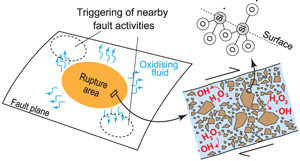 | Generation of oxidising fluids by comminution of fault rocks Abstract: Mechanochemical reactions exert a crucial control on the chemical environments of crustal fault zones during co-seismic and post-seismic periods. Comminution due to faulting causes activation of fault rock surfaces, such as the production of reactive radical species. In this study, we report on the generation of H2O2 by immersion of comminuted sedimentary, igneous, and metamorphic rocks that are broadly representative of those present at a variety of depths in subduction zones. Our experiments demonstrate that fresh surfaces of these rocks have an H2O2 productivity of 1.3–10.4 nmol m−2 (mean = 5.4 nmol m−2). In a natural fault zone environment, H2O2 produced after a slip event is likely to react with Fe-bearing mineral surfaces or Fe2+ in porewater, or thermally decompose to produce more oxidative ·OH. The oxidising fluid produced by fault rupture in one patch may spread and induce corrosion and degradation of surrounding fault zones. These chemical processes are likely to be important factors influencing the interaction between neighbouring seismic activities. |
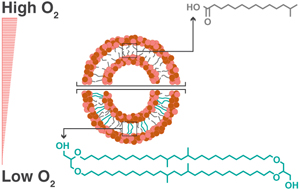 | Oxygen limitation can trigger the production of branched GDGTs in culture Abstract: Branched glycerol dialkyl glycerol tetraethers (brGDGTs) are ubiquitous and well-preserved sedimentary biomarkers. These compounds serve as important palaeoenvironmental indicators due to strong empirical correlations between brGDGT distributions and temperature and pH in modern environments. However, the mechanistic link between temperature, pH, and brGDGT production has been difficult to study due to uncertainty about the organisms and physiological conditions required for the synthesis of brGDGTs in nature. Here, we report that in the Acidobacterium Edaphobacter aggregans, severe oxygen limitation (1% O2) leads to significant brGDGT production (2.9% of membrane lipids) with three structural varieties including an uncharacterised isomer of brGDGT Ic. Low O2 as a physiological trigger for brGDGT production may help explain why brGDGT producers have been so difficult to identify, and provides a new path towards uncovering the genetic basis and biological function of brGDGTs. If the oxygen effects observed here apply more broadly, the empirical calibrations for brGDGT-based temperature and pH reconstructions may currently be missing the effects of oxygen as a relevant and possibly dominant control in the environmental distributions of brGDGTs. |
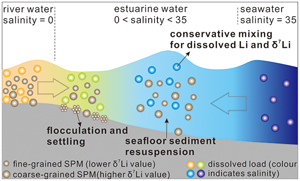 | Decoupling of dissolved and particulate Li isotopes during estuarine processes Abstract: Lithium isotopes in marine authigenic or detrital sedimentary archives have been recently used to trace continental weathering over geologic timescales. However, interpretations are predominantly based on the assumption that riverine Li isotopic signals can be propagated through estuaries without modification. Here, we verify this hypothesis by investigating the behaviour of Li isotopes in the Changjiang (Yangtze) River estuary. We observe a conservative mixing of dissolved Li and its isotopes between the Changjiang River water and seawater. The dissolved δ7Li yields a non-linear increase with salinity, and a significant increase occurs during the initial water mixing. Through the studied transect, estuarine flocculation and resuspension processes cause the homogenisation of offshore particulate δ7Li values, which are close to the average composition of upper continental crust. This study provides clear and direct evidence that the riverine dissolved Li isotopic signal is not modified during estuarine processes in large rivers, but caution should be exercised when using detrital δ7Li in marginal seas to investigate past continental weathering. |
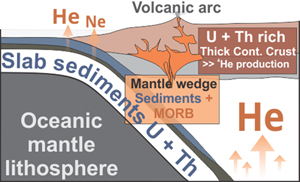 | Crustal controls on light noble gas isotope variability along the Andean Volcanic Arc Abstract: This study combines new noble gas data from fluid inclusions in minerals from Sabancaya, Ubinas, and El Misti (CVZ, Peru) and Villarica (South Chile, SVZ) with a revised noble gas compilation in the Andes, to identify systematic along arc variations in helium isotope compositions. We find 3He/4He ratios varying from 8.8 RA (Colombia) to 7.4 RA (Ecuador) within the NVZ, and only as high as 6.4 RA in the CVZ (RA is the atmospheric 3He/4He ratio of 1.39 × 10–6). These distinct isotope compositions cannot be explained by variable radiogenic 4He production via slab fluid transport of U and Th in the mantle wedge, since both NVZ and CVZ share similar slab sediment inputs (Th/La ≈ 0.08–0.13). Instead, the progressively more radiogenic 3He/4He signatures in Ecuador and Peru reflect 4He addition upon magma ascent/storage in the crust, this being especially thick in Peru (>70 km) and Ecuador (>50 km) relative to Colombia (∼30–45 km). The intermediate compositions in the North (8.0 RA) and South (7.9 RA) Chile, both high sediment flux margins, mostly reflect a more efficient delivery of radiogenic He in the wedge from the subducted (U-Th-rich) terrigenous sediments. Our results bring strong evidence for the major role played by crustal processes in governing noble gas compositions along continental arcs. |
<< Previous issueNext issue >>


